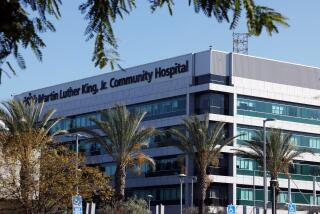Elation Is Building : CHOC Eagerly Prepares for Move Into Its New State-of-the Art Care Facility
ORANGE â When Sidney J. Adler started his medical practice in Orange County about 40 years ago, few local hospitals had a pediatric ward, and those that did were not equipped to handle a child with cancer or a bad case of pneumonia.
âThey might have had space. But you wouldnât want to send your severely ill child there,â the retired pediatrician said matter-of-factly. âIf I had a severely ill patient, Iâd have to send him to Childrens Hospital Los Angeles or to UCLA.â
So Adler and several colleagues led a drive to build a childrenâs hospital in Orange County. With support from luminaries Walt Disney and Walter Knott, as well as pennies from schoolchildren, they opened the nonprofit Childrenâs Hospital of Orange County in 1964 in a 62-bed wing leased from St. Joseph Hospital in Orange.
Eleven years later, it expanded into a five-story, 99-bed CHOC Tower across the street from St. Joseph. Administrators leased another 62 beds in a nearby St. Josephâs building.
At dawn Saturday, the hospital will take another stride forward when nurses move their young charges from the outdated tower through CHOCâs basement tunnels and into a $45-million, 196-bed hospital designed just for children.
The new seven-story building boasts the latest in medical technology. Four laminar-flow rooms will bathe infection-prone cancer patients in a stream of germ-free air. Computer monitors beside every bed will allow nurses to chart a patientâs progress in seconds.
Even Adler, CHOCâs second chief of staff, is amazed by the new state-of-the-art hospital, calling it âbeyond my wildest dreams.â
Actually he should not be so surprised. Long before the new building was finished, CHOC had become a regional childrenâs hospital on a par with the Miller Childrenâs Hospital division of Long Beach Memorial Medical Center; Childrens Hospital of Los Angeles, and in most areas--except pediatric liver transplants and complex cardiac surgery--UCLA Medical Center.
CHOC is distinguished in several specialties, including diabetes, cystic fibrosis, neonatology and cancer. In recent years, 10% of CHOCâs patients have come from surrounding counties, and some as far away as Oakland. Nearly a third of the patients in CHOCâs strong oncology program come from out of county for bone marrow transplants, chemotherapy and national experimental trials.
For all the excitement about CHOCâs move, it will not mean fundamental change at the hospital, administrators say.
The oncology and pediatric cardiology programs will expand, but mostly âweâre just enhancing our ability to give specialized care to children in an environment specially designed for that,â said Dr. Barbara Towne, president of CHOCâs medical staff.
Actually design--or rather, bad design--was the impetus for CHOCâs move. Over the past six years, it was increasingly obvious that the five-story CHOC Tower--designed in 1969 as a convalescent home--could no longer be used as a childrenâs hospital, CHOC leaders said.
Hoping at first to remodel, âwe hired a set of engineers to go through the building,â CHOC President Thomas Penn Jones said recently. Their recommendation to build a new hospital sent CHOC leaders into a state of shock, he said, âso we brought in another engineering firm.â It too said: âBuild.â
Jones and CHOC vice president Brian Mottishaw can tick off a long list of problems with CHOC Tower. Chief among them: Space between the ceilings and concrete floors is inadequate to add special ventilation systems and electrical wiring for modern pediatric isolation rooms.
When CHOC began its bone marrow transplant program for leukemia patients six years ago, there was no room in CHOC Tower to add equipment to create germ-free isolation rooms. Instead, the special rooms had to be built in leased space at a nearby St. Joseph building.
By contrast, the new hospital has plenty of floor-to-ceiling space. And its seventh floor houses a special air filtration system for the transplant rooms and for isolation rooms in neonatal and pediatric intensive care.
Four $100,000 bone marrow transplant rooms have been built with laminar flow. Designed to protect immune-suppressed cancer patients, for whom the slightest taint of bacteria could mean deadly infection, special blowers push a steady stream of germ-free air over a childâs bed. A wall of clear vinyl allows a nurse to tend her patient without entering his room, reaching inside by donning built-in plastic sleeves.
To add creature comforts for the transplant patient who may spend months in this enclosure, each new isolation room has a private bathroom; the old rooms lacked bathrooms, so their patients had to use bedpans.
Other changes:
* Because the old hospital had no room for a helipad, patients who came by helicopter--infants rushed to neonatal intensive care or children with cancer from distant counties--landed at a fire station helipad near Anaheim Stadium, 2 miles away, then were moved by ambulance to CHOC. At commute hour, this could mean a lengthy ride for a sick child, CHOC vice president Mottishaw said.
The new building has a rooftop helipad, plus a nearby elevator to whisk patients into the hospital.
* The CHOC Tower had no private rooms and many rooms with three and four beds. When children needed to be isolated, other beds in the room were left empty. The new building has 96 private rooms.
* The new hospital is more amenable to parents, with brighter lounges and, for the first time, showers for parents.
Of course, the latest in medical technology does not come cheap. Total construction costs are expected to reach $58 million--$45 million to build the hospital and the rest to tear down CHOC Tower, build the new hospitalâs main lobby and a radiology area in its place and pay for a nearby research building.
To pay for the project, the hospital drew on $31 million in reserves and this fall raised more than $4 million from its doctors, other employees and 15 support groups. A public fund-raising campaign has begun.
But once it became evident that âit was difficult in a recessionâ to raise money from the countyâs business leaders, the hospital arranged $25 million in tax-exempt bonds, Jones said.
For all of Jonesâ worries over last-minute details, the best word to describe his mood and that of his staff as the new hospital opens is elation.
âAfter all these years of planning, itâs finally here! Itâs finally here!â he said.
More to Read
Sign up for Essential California
The most important California stories and recommendations in your inbox every morning.
You may occasionally receive promotional content from the Los Angeles Times.










